As I stand in my garden, surrounded by the beauty of nature, I can’t help but feel a sense of tranquility and joy. The vibrant colours, the gentle breeze, and the melodious songs of birds fill my heart with happiness. It is in these moments that I truly appreciate the power of plants to evoke emotions and create a sanctuary in our own backyard.
One plant in particular has captured my attention and stolen a special place in my heart – Mahonia Soft Caress. This evergreen shrub, with its delicate, fern-like foliage and clusters of cheerful yellow flowers, brings a touch of magic to any garden. Its compact growth and year-round interest make it a beloved choice for gardeners seeking a low maintenance, shade-tolerant plant with lasting beauty.
But its allure doesn’t end there. The Mahonia Soft Caress plant is not only a feast for the eyes, but also a haven for wildlife. Its evergreen foliage provides shelter for birds and small mammals, while the nectar-rich flowers attract butterflies and bees, creating a thriving ecosystem right in your own backyard.
Not to mention, Mahonia Soft Caress is deer-resistant, saving you from the heartache of nibbled foliage and damaged blooms. It’s a resilient and enduring beauty that will grace your garden year after year, season after season.
Appearance of Mahonia eurybracteata

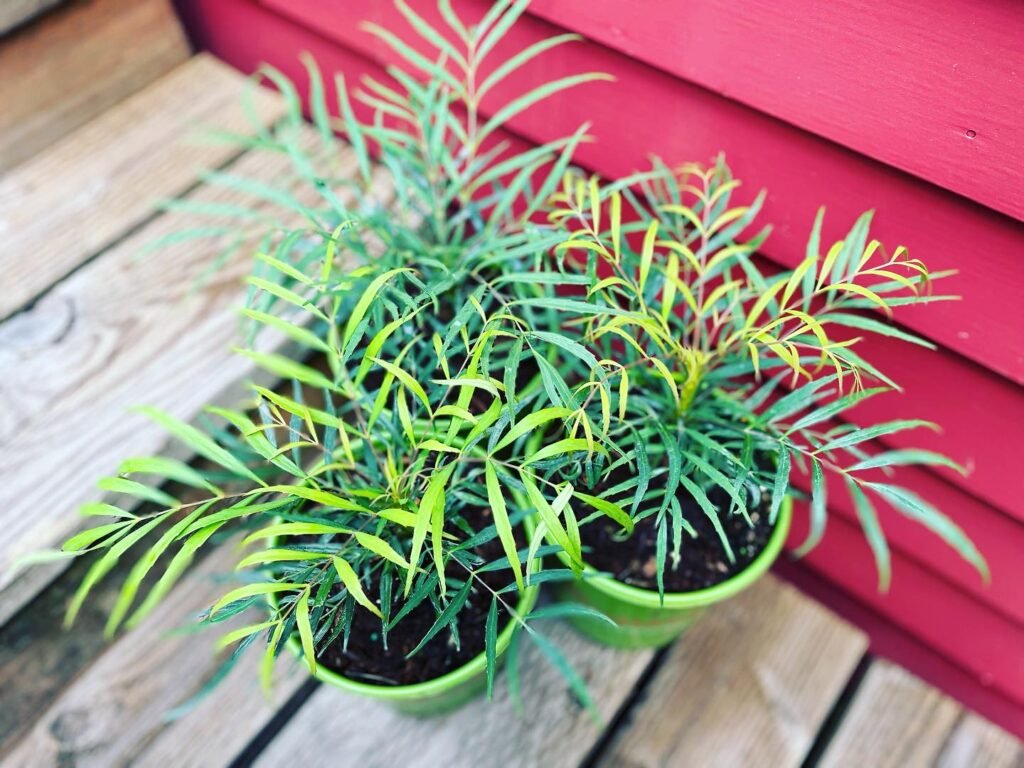
Mahonia eurybracteata, also known as Soft Caress, is a stunning evergreen shrub that adds beauty to any landscape. It is characterized by its narrow, spine-free leaflets and compact growth habit. The plant’s elegant foliage provides year-round interest, making it a popular choice for gardens in the United Kingdom.
There are several varieties of Mahonia Soft Caress, each with its own unique characteristics. Whether you’re looking for a hedge plant, a border plant, or a focal point in your garden, there is a Mahonia Soft Caress variety that will suit your needs.
Within the Mahonia family, ‘Soft Caress‘ and Mahonia japonica stand out for their unique qualities, offering something special for every UK garden. ‘Soft Caress‘ is celebrated for its variety, with each type bringing its own flair—be it as a hedge, a border accent, or a garden centerpiece. Mahonia japonica, with its classic appeal, complements this range beautifully, providing options for those seeking a more traditional look or needing a robust plant for screening or as a garden anchor.
When planting Mahonia Soft Caress, it’s important to choose a location that provides partial shade and well-drained soil. This plant thrives in areas with filtered sunlight and can tolerate a range of soil conditions. To ensure optimal growth, you can enrich the soil by adding organic matter to the planting hole. This will enhance soil fertility and promote healthy growth.
 Even though it looks quite dainty, Mahonia eurybracteata ‘Soft Caress’ is really tough, especially against city smoke and grime. It’s brilliant for city gardens because it doesn’t mind pollution and isn’t bothered much by pests. So, if you’re new to gardening and live in a town or city, this plant could be a great start for you.
Even though it looks quite dainty, Mahonia eurybracteata ‘Soft Caress’ is really tough, especially against city smoke and grime. It’s brilliant for city gardens because it doesn’t mind pollution and isn’t bothered much by pests. So, if you’re new to gardening and live in a town or city, this plant could be a great start for you.
Light Requirements for Mahonia Soft Caress
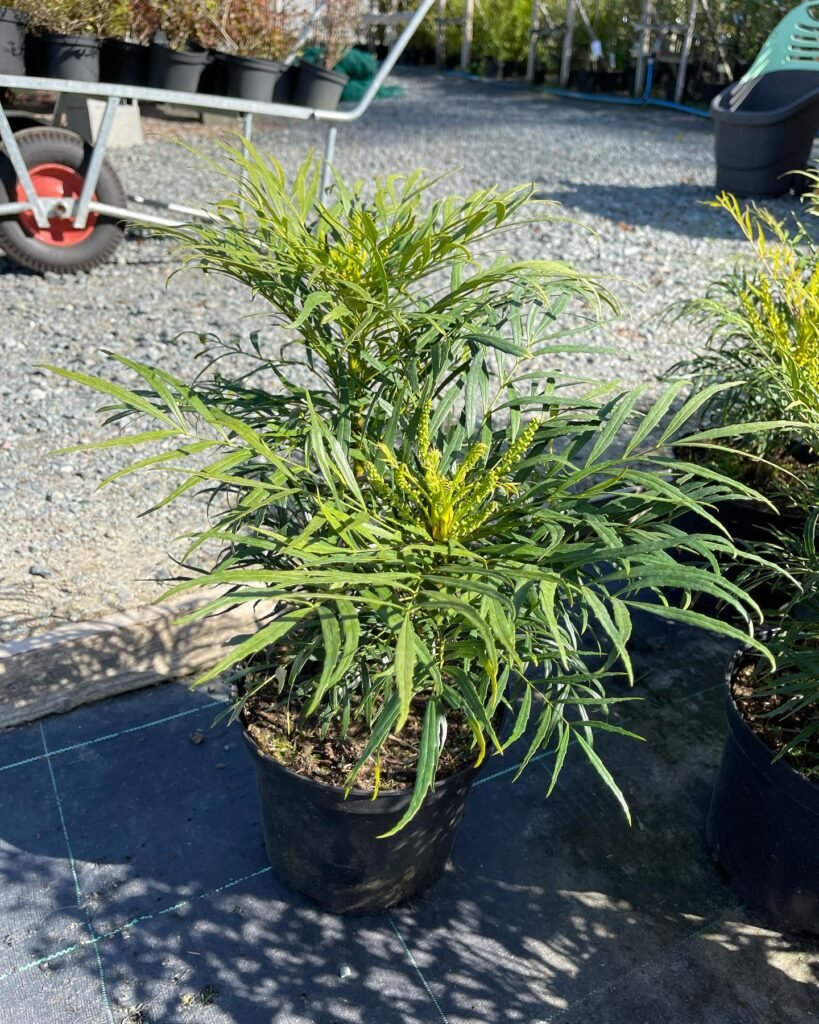
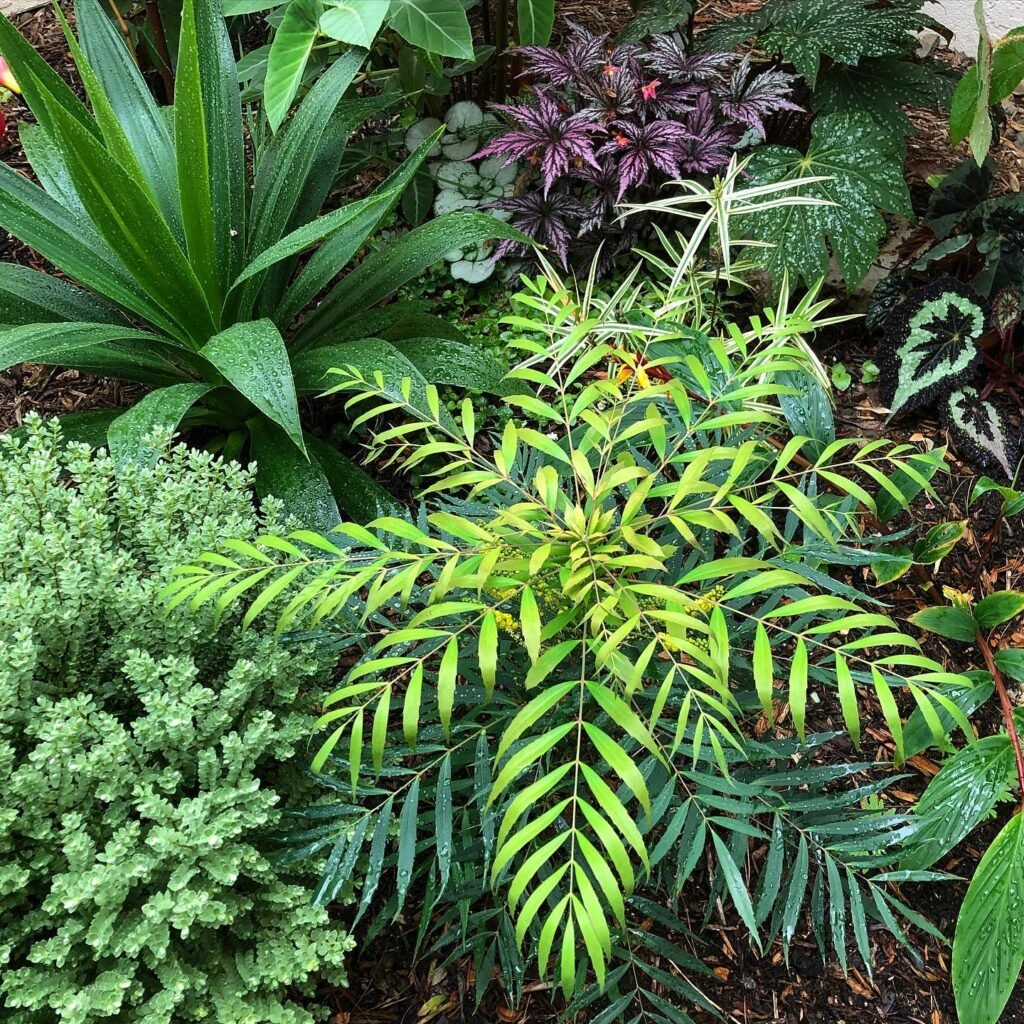
Mahonia Soft Caress, an evergreen shrub, requires the right amount of sunlight to thrive in your garden. It prefers partial shade to full sun, allowing it to flourish while offering some protection from direct sunlight. However, it’s important to strike the right balance, as too much shade can result in poor flowering and less compact growth.
When choosing a location for your Mahonia Soft Caress, consider the amount of sunlight it will receive throughout the day. Placing it in an area where it can receive adequate sunlight will promote healthy growth, vibrant flowers, and overall plant vigor.
Remember, Mahonia Soft Caress is a shade-tolerant plant, but it still requires some exposure to sunlight to reach its full potential. With the right light conditions, your Mahonia Soft Caress will reward you with year-round beauty and a stunning display of vibrant yellow flowers.

Watering Tips for Mahonia Soft Caress

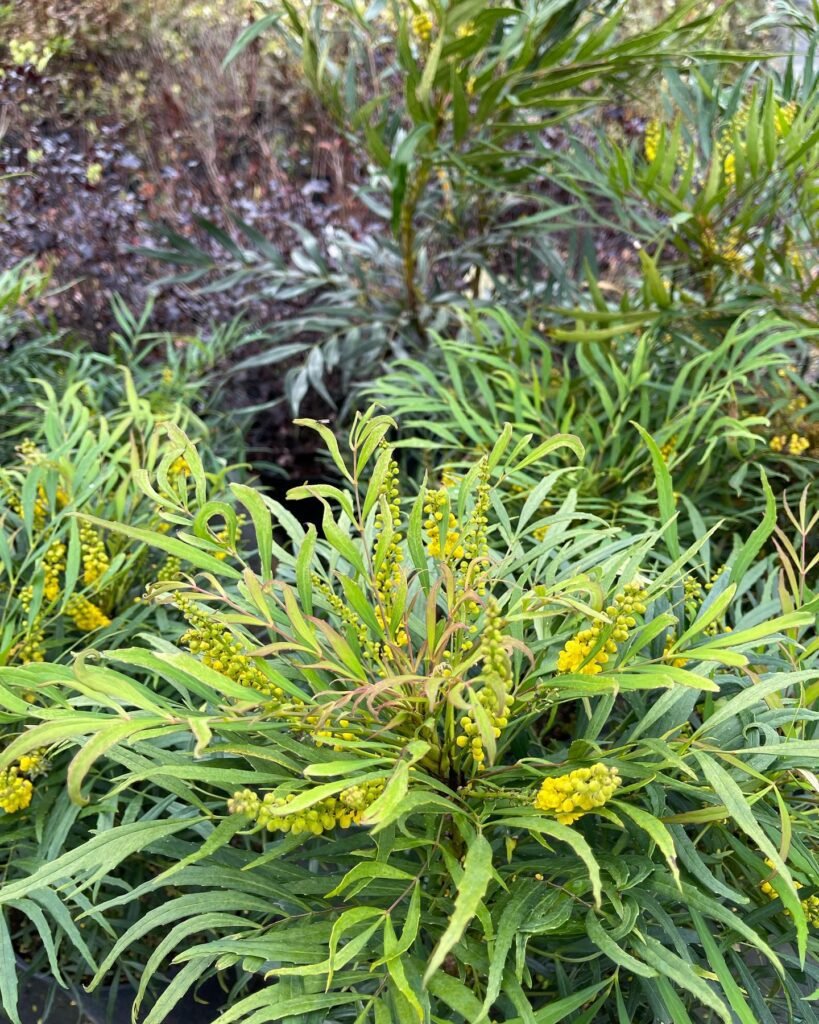
Mahonia Soft Caress, like all plants, has specific care and growing conditions that need to be met for its optimal health and vitality. Proper watering is essential to ensure the plant’s well-being. Mahonia Soft Caress has average water needs and prefers a moist, well-drained soil. Regular watering is important, especially during dry spells or hot summer months, to prevent dehydration and promote healthy growth. It’s essential to monitor the soil moisture and adjust the watering frequency accordingly.
However, it’s important to strike the right balance when it comes to watering Mahonia Soft Caress. Overwatering can lead to root rot and other issues, so it’s crucial not to drown the plant in excessive water. On the other hand, underwatering can result in stress and hinder the plant’s growth. It’s best to adhere to a consistent watering schedule and ensure the soil is evenly moist.
Some Mahonia varieties, including Soft Caress, are known for their drought tolerance. Once established, these varieties can withstand periods of dryness. However, it’s important to note that even drought-tolerant plants benefit from regular watering, especially during prolonged dry spells. Monitoring the plant’s hydration needs is key to maintaining its health and vitality.
| Watering Tips for Mahonia Soft Caress | Guidelines |
|---|---|
| Water Needs | Average water needs; keep soil moist |
| Watering Frequency | Regular watering, especially during dry spells or hot summer months |
| Overwatering | Avoid overwatering to prevent root rot |
| Underwatering | Ensure the soil is evenly moist to prevent stress |
| Drought Tolerance | Some Mahonia varieties, including Soft Caress, can withstand periods of dryness once established. Regular watering is still recommended. |

Fertilizing and Soil for Mahonia Soft Caress
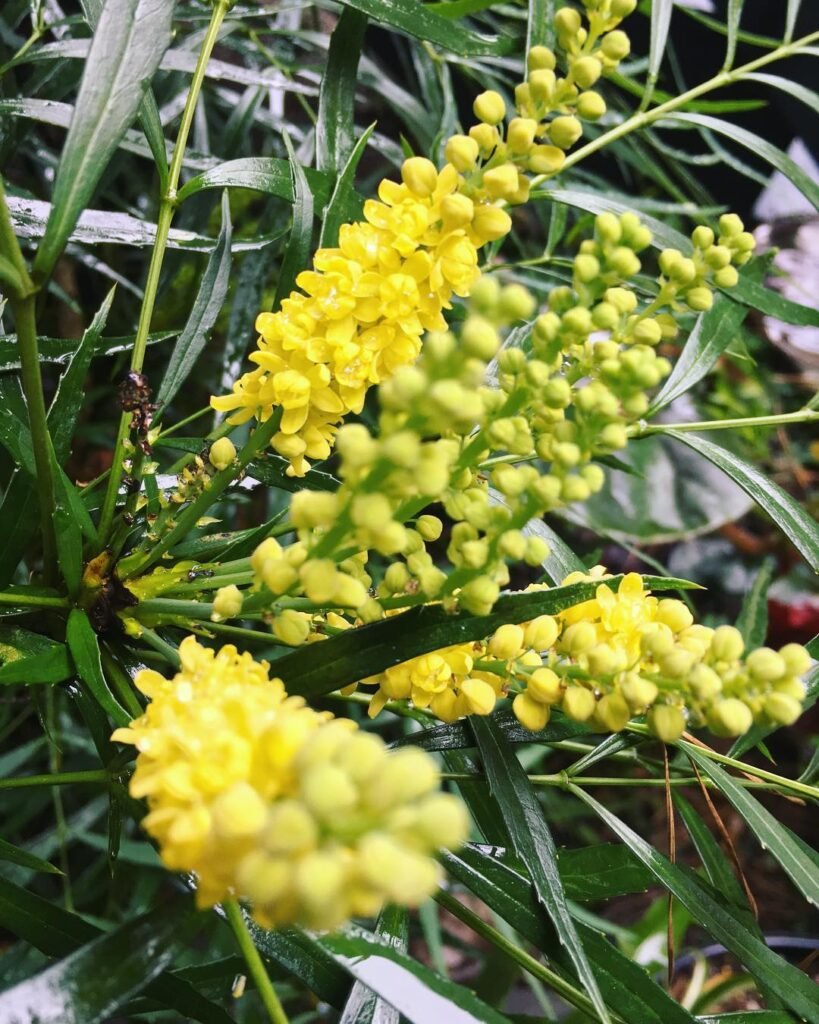
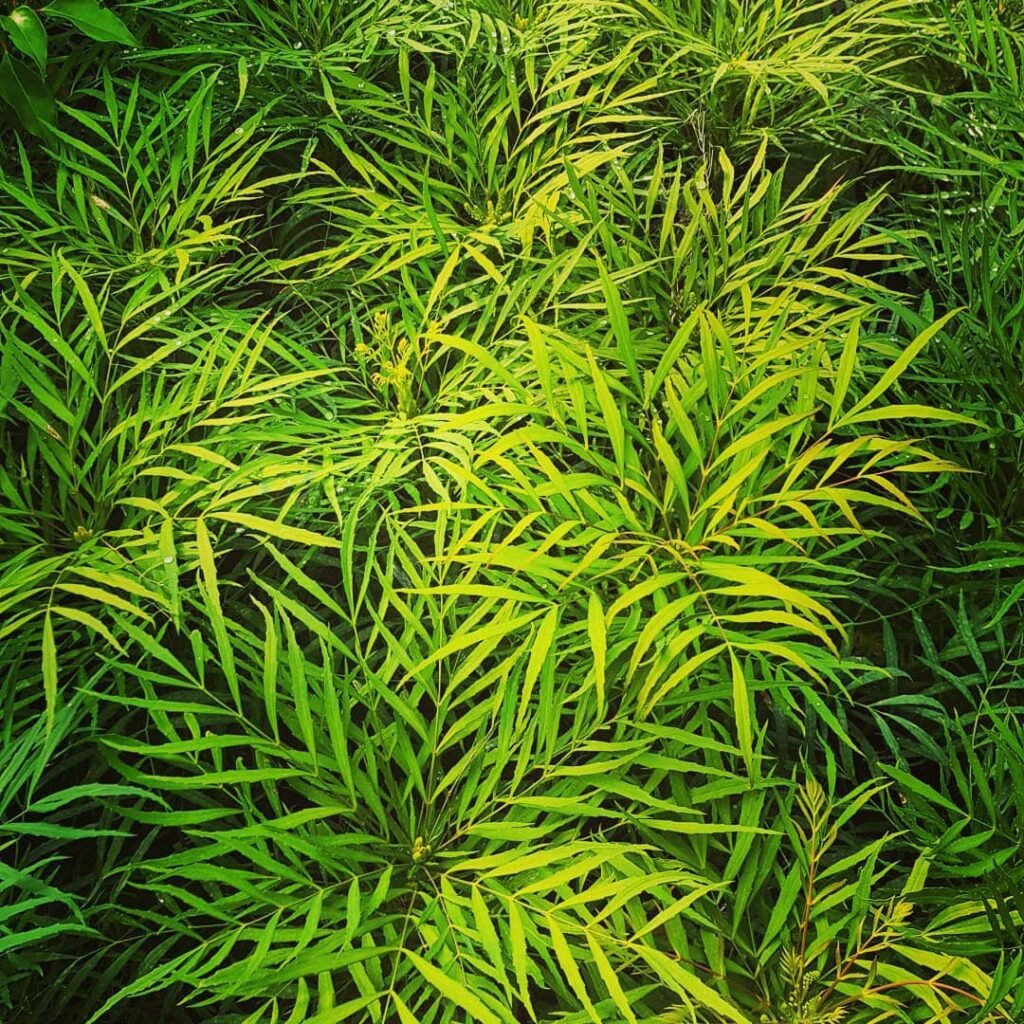
When it comes to the soil requirements of Mahonia Soft Caress, it prefers a moderately fertile, humus-rich soil that is well-drained. To create the ideal soil environment for this plant, it is recommended to add organic matter, such as compost or well-rotted manure, which not only improves the fertility but also enhances the drainage capabilities of the soil. This will ensure that the roots of Mahonia Soft Caress have access to the necessary nutrients and moisture while avoiding waterlogged conditions.
Additionally, fertilizing the Mahonia Soft Caress plant can further promote its healthy growth and overall vitality. It is best to use a balanced, slow-release fertilizer in the spring, following the manufacturer’s instructions for application rates and timings. This allows for a steady release of nutrients over time, providing the plant with a consistent source of nourishment.
Regular soil testing is also beneficial for Mahonia Soft Caress as it helps identify any nutrient deficiencies that may be present in the soil. By knowing the specific nutrient requirements of the plant, gardeners can make informed decisions about the appropriate fertilizers to use and ensure that the plant receives the optimal nutrition for optimal growth.
| Soil Type | Characteristics |
|---|---|
| Well-drained soil | – Allows excess water to drain freely, preventing waterlogging – Promotes oxygen flow to the root system – Prevents root rot and other water-related issues |
| Moderately fertile soil | – Provides adequate nutrients for healthy plant growth – Supports vigorous flowering and foliage development |
| Humus-rich soil | – Enhances soil texture and structure – Improves water-holding capacity – Promotes beneficial microbial activity in the soil |
Proper fertilizing and soil management are crucial for the success of Mahonia Soft Caress. By ensuring the soil is well-drained, moderately fertile, and enriched with organic matter, gardeners can create optimal conditions for this beautiful plant to thrive. Pairing these soil requirements with mindful fertilizing practices will result in a healthy and vibrant Mahonia Soft Caress in your garden.

Pruning and Maintenance of Mahonia Soft Caress
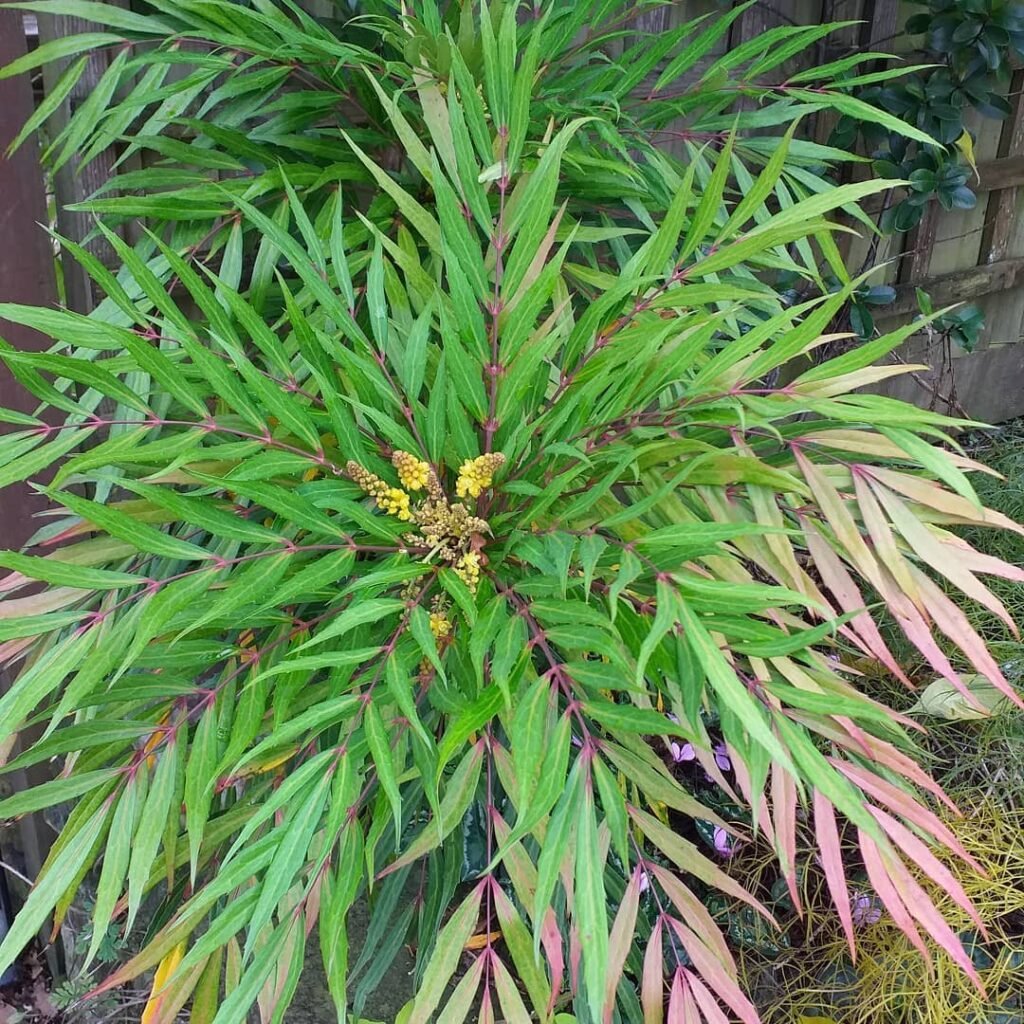
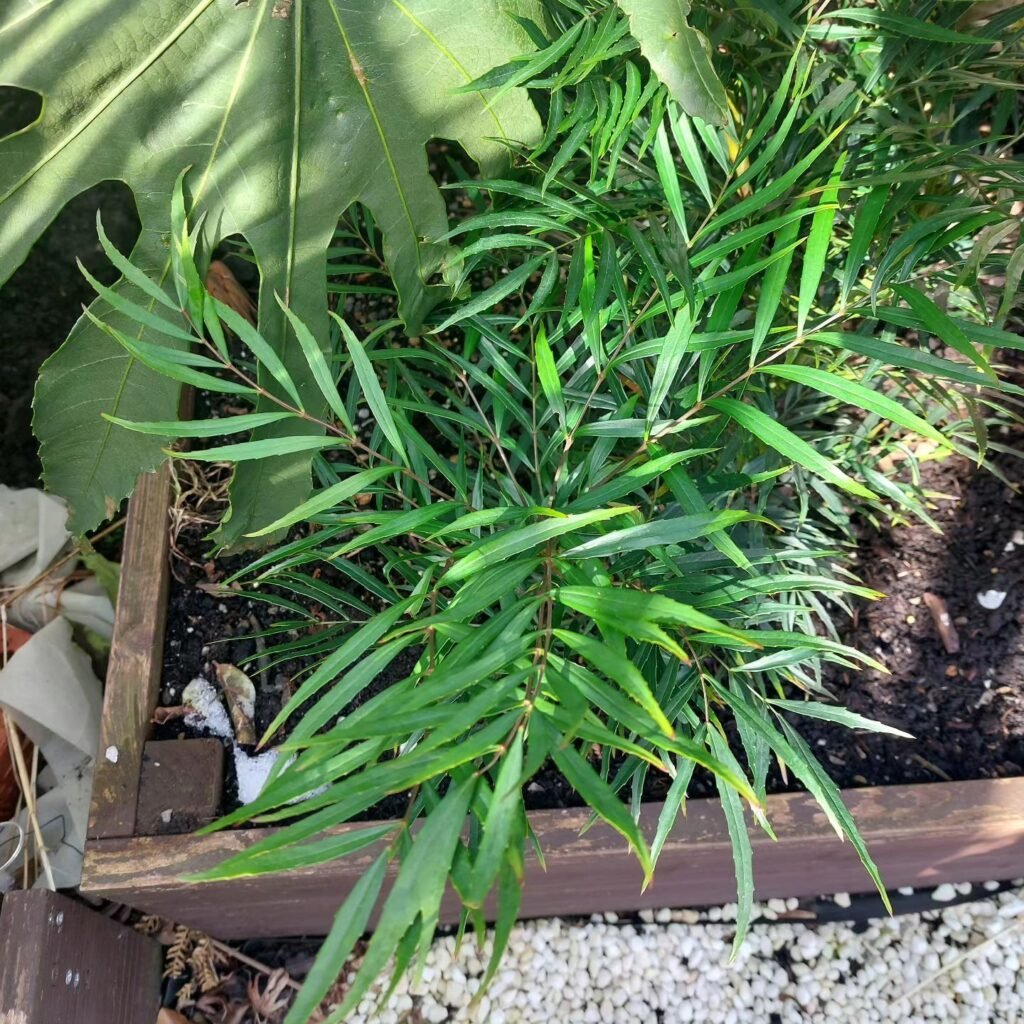
Pruning plays a crucial role in the overall maintenance of Mahonia Soft Caress. To ensure its health and promote vigorous growth, it is recommended to prune the plant in mid to late spring. This timing allows for the removal of any dead or damaged branches, encouraging new growth and enhancing the plant’s overall appearance.
During the pruning process, it is important to wear protective gloves and equipment, as Mahonia Soft Caress has spiky leaves. By carefully removing these unwanted branches, the plant can maintain its compact shape and maximize its potential for flowering.
In addition to removing dead or damaged branches, it is also essential to address any suckers or undesired growth that may appear at the base of the plant. By removing these unwanted shoots, the plant’s energy can be directed towards its proper development and flowering.
“Regular pruning promotes a more compact shape and encourages better flowering.”
| Pruning Benefits: | How to Prune: |
|---|---|
| Promotes healthy growth | – Prune in mid to late spring – Remove dead or damaged branches – Address suckers or unwanted growth |
| Maintains compact shape | – Wear gloves and protective equipment – Carefully remove spiky leaves – Direct plant’s energy towards proper development |
| Enhances flowering | – Regular pruning for optimal health – Retains aesthetically pleasing form – Maximizes the plant’s potential |

Propagating Mahonia Soft Caress

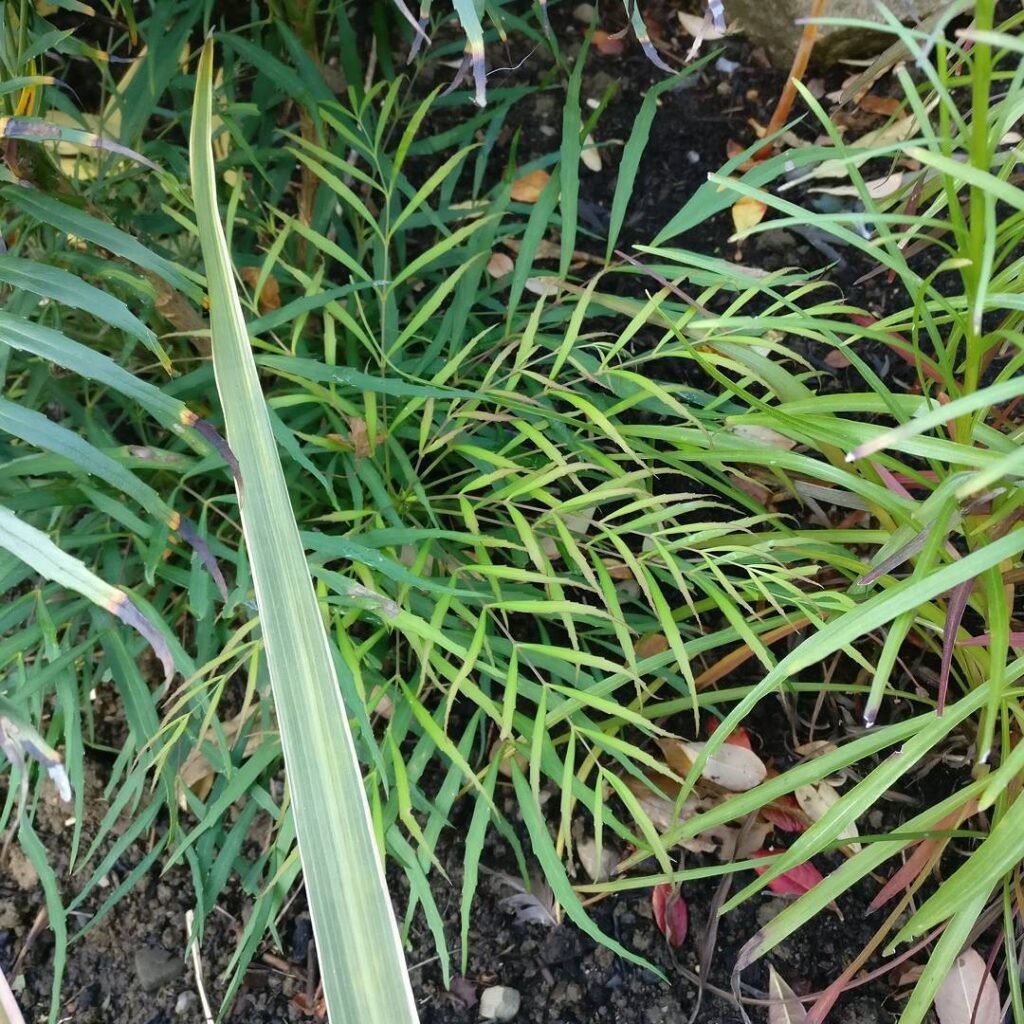
Propagating Mahonia Soft Caress is a simple and rewarding process that allows you to expand your collection or share this beautiful plant with others. One effective method of propagation is through semi-hardwood cuttings. Here’s a step-by-step guide:
- Select healthy shoots from the Soft Caress plant that are not currently flowering.
- Cut the shoots to a length of 4-6 inches, making sure to use clean, sharp secateurs.
- Remove the lower leaves from the cutting, leaving only a few leaves at the top.
- Dip the cut end of the stem in rooting hormone to promote root development.
- Prepare a well-draining potting mix, such as a mixture of peat moss and sand.
- Plant the cuttings in the potting mix, making sure to bury them deep enough so that they stand upright.
- Place the pot in a warm and bright location, but avoid direct sunlight.
- Keep the soil consistently moist, but not waterlogged, to provide the right conditions for root development.
- Encourage humidity by covering the pot with a plastic bag or placing it in a propagator.
- After a few weeks, the cuttings should start developing roots.
- Once the roots have formed, transplant the cuttings into individual pots or the garden, ensuring they have enough space to grow.
This method of propagation allows you to create new Mahonia Soft Caress plants that will exhibit the same desirable traits as the parent plant, such as its compact growth and beautiful yellow flowers. It’s a wonderful way to expand your garden or share the joy of this exceptional plant with others.

Repotting Tips for Mahonia Soft Caress
Are you looking to repot your Mahonia Soft Caress plant? Whether you want to refresh its look or give it a new home in a container, repotting can help promote healthy growth and provide a fresh start for your plant. Here are some useful tips to guide you through the repotting process:
- Choose the right size pot: Select a pot that is slightly larger than the current container of your Mahonia Soft Caress plant. This will allow room for its roots to grow and prevent them from becoming cramped.
- Opt for well-draining potting mix: Mahonia Soft Caress prefers well-draining soil, so using a high-quality potting mix specifically formulated for container plants is essential. This will help prevent waterlogging and ensure proper root development.
- Ensure good drainage: It is crucial to choose a new container with drainage holes to allow excess water to escape. Adequate drainage will safeguard your plant from root rot or other related issues.
- Handle with care: When removing the plant from its current pot, be gentle to avoid damaging the roots. Gently tap the sides of the container and carefully loosen the soil to ease the plant’s removal.
- Position in the new container: Place the Mahonia Soft Caress plant in its new container, ensuring it sits at the same soil level as before. Fill any gaps around the roots with additional potting mix, gently pressing it down for stability.
- Water thoroughly: After repotting, give your Mahonia Soft Caress plant a good watering to settle the soil. This will help remove any air pockets and establish proper contact between the roots and the new growing medium.
Growing Mahonia Soft Caress in the UK
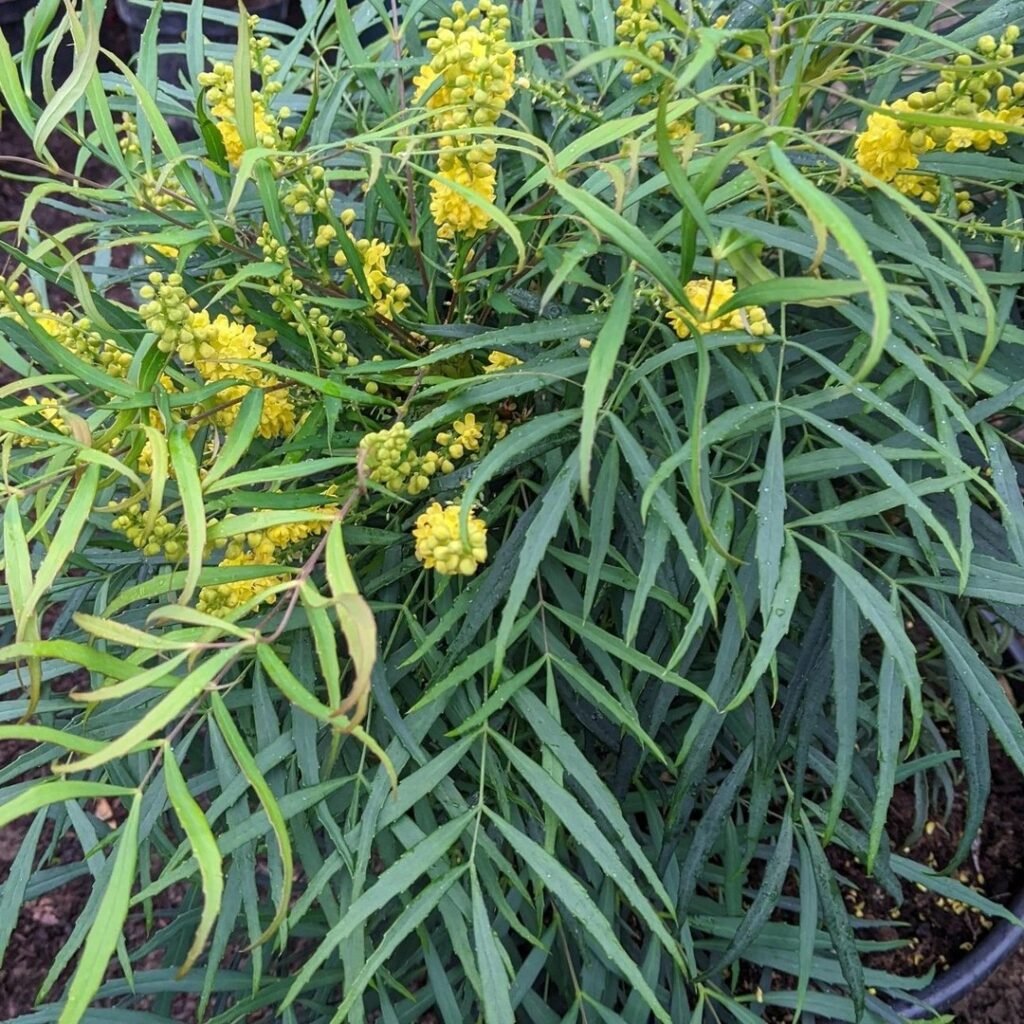

Mahonia Soft Caress, specifically the Mahonia eurybracteata Ganpinensis Soft Caress variety, is a hardy and versatile plant that thrives in various growing conditions typically found in UK gardens. With its low maintenance requirements and adaptability, it is an excellent choice for both experienced and novice gardeners.
This evergreen shrub is generally disease-free and resistant to pests, making it an ideal addition to any garden. However, occasional inspections and proper care are necessary to keep the plant healthy and thriving. Ensuring proper watering and maintaining well-balanced soil conditions are essential for optimal growth.
Mahonia Soft Caress can also be used as an attractive ground cover, adding depth and texture to garden beds. Its compact growth and attractive foliage make it a popular choice for landscaping projects.
During the winter months, Mahonia Soft Caress requires some special care. Mulching around the base of the plant helps protect the roots from freezing temperatures, ensuring its vitality when spring arrives.
The adaptability, low maintenance requirements, and aesthetic appeal of Mahonia Soft Caress make it a valuable addition to any UK garden. By providing the right care and conditions, this plant will thrive and enhance the beauty of your outdoor space.
 Mahonia eurybracteata ‘Soft Caress’, celebrated for its spine-free leaves, is the first spineless Mahonia to earn the Royal Horticultural Society’s Award of Garden Merit. Its unique foliage and yellow blooms are not only visually striking but also support local wildlife by feeding pollinators during colder months.
Mahonia eurybracteata ‘Soft Caress’, celebrated for its spine-free leaves, is the first spineless Mahonia to earn the Royal Horticultural Society’s Award of Garden Merit. Its unique foliage and yellow blooms are not only visually striking but also support local wildlife by feeding pollinators during colder months.
Mahonia Soft Caress Companion Plants
Mahonia Soft Caress, with its graceful appearance and vibrant yellow flowers, can be enhanced by pairing it with suitable companion plants. By selecting the right plants, you can create visually pleasing combinations that complement the texture and colour of Mahonia Soft Caress, resulting in a cohesive and attractive garden display.
Some excellent choices for companion plants to Mahonia Soft Caress include:
- Heuchera: These shade-loving perennials, also known as coral bells, add a splash of colour to the garden with their stunning foliage variations.
- Hellebores: These evergreen perennials produce exquisite flowers in shades of white, pink, and purple, providing a beautiful contrast to Mahonia Soft Caress.
- Ferns: With their delicate fronds and lush greenery, ferns create a stunning backdrop and add an elegant touch to the garden.
- Other Shade-Loving Perennials: Consider plants such as tiarella, hostas, and pulmonaria, which thrive in shady conditions and complement the beauty of Mahonia Soft Caress.
When selecting companion plants, it is essential to consider their specific light and soil requirements. Choosing plants that have similar growing conditions to Mahonia Soft Caress will ensure that they thrive in harmony and create a visually pleasing garden ensemble.
An Example of Companion Plants for Mahonia Soft Caress
| Companion Plant | Description |
|---|---|
| Heuchera (Coral Bells) | These colourful perennials offer attractive foliage in various shades, adding visual interest alongside Mahonia Soft Caress. |
| Hellebores | With their stunning flowers and evergreen foliage, hellebores create a captivating display when planted alongside Mahonia Soft Caress. |
| Ferns | Feathery fronds of ferns provide a beautiful backdrop and soft texture that complements the elegance of Mahonia Soft Caress. |
| Other Shade-Loving Perennials | Consider tiarella, hostas, and pulmonaria to create a diverse and visually appealing garden composition with Mahonia Soft Caress. |
Together, these companion plants will create a harmonious and stunning garden display, enhancing the overall beauty of Mahonia Soft Caress.
Wildlife Benefits of Mahonia Soft Caress
Mahonia Soft Caress is not only a beautiful addition to any garden, but it also provides numerous benefits to wildlife, making it a valuable asset for creating a wildlife-friendly environment.
The vibrant yellow flowers of Mahonia Soft Caress are known to attract various pollinators, such as bees, butterflies, and other beneficial insects. These pollinators play a crucial role in plant reproduction and contribute to the overall biodiversity of the garden. By attracting pollinators, Mahonia Soft Caress helps to support the health and vitality of the surrounding flora.
Furthermore, the blue-black berries that follow the flowers serve as a valuable food source for birds during the colder months when other food options may be scarce. While these berries are not typically eaten by humans, they are enjoyed by a wide range of bird species. By planting Mahonia Soft Caress, gardeners can create bird-friendly gardens and contribute to the conservation of local bird populations.
Overall, Mahonia Soft Caress offers a delightful garden display while also serving as a vital resource for pollinators and birds. Planting Mahonia Soft Caress is a wonderful way to support wildlife and contribute to the preservation of local species, making it an excellent choice for any wildlife enthusiast.
Mahonia Soft Caress in Sustainable Gardening
Mahonia Soft Caress is a fantastic choice for sustainable gardening practices. Its low maintenance requirements make it ideal for busy gardeners like myself who are passionate about creating an environmentally-friendly garden. By opting for low maintenance shrubs such as Mahonia Soft Caress, we can reduce the need for excessive pruning, watering, and fertilizing, resulting in a more sustainable and eco-friendly garden.
One of the remarkable qualities of Mahonia Soft Caress is that it is an evergreen plant, providing year-round interest and serving as a natural privacy screen. As urban gardens often have limited space, the compact growth habit of Mahonia Soft Caress makes it a perfect fit for landscaping. Its versatility allows it to thrive in both small and large gardens, adding a touch of greenery to urban spaces while requiring minimal maintenance.
When we incorporate Mahonia Soft Caress into our gardens, we foster sustainable practices by ensuring that these beautiful evergreen shrubs thrive without imposing excessive demands on our time or resources. Their low maintenance needs, combined with their ability to withstand various environmental conditions, make them an excellent choice for urban garden evergreens. By embracing low maintenance garden shrubs like Mahonia Soft Caress, we can create sustainable gardens that are both visually appealing and environmentally responsible.
Helpful Video About Growing Mahonia Soft Caress
Fancy giving Mahonia ‘Soft Caress’ a go in your garden? I’ve lined up some fantastic videos just for you. Packed with straightforward advice, these guides cover everything from the essentials to a few clever tricks, ensuring your plant gets off to the best start. Whether you’re a seasoned gardener or just dipping your toes into the world of plants, these videos make caring for Mahonia ‘Soft Caress’ both easy and enjoyable.
- How to grow Soft Caress Mahonia (Evergreen Shade Shrub with Yellow Flowers)
- Facts About Soft Caress Mahonia
- Mahonia eurybracteata ‘Soft Caress’ ~ Soft Caress Mahonia
FAQ about Growing Mahonia eurybracteata (Soft Caress)

Interested in making your Mahonia ‘Soft Caress’ the star of your garden? Dive into my handy FAQ for all the insider tips on looking after your Mahonia ‘Soft Caress’. I’ve covered everything from the perfect spot for planting to the ins and outs of watering, ensuring your plant not only survives but thrives.
Mahonia ‘Soft Caress’ thrives in well-drained, moderately fertile soil that’s rich in organic matter. Adding compost or well-rotted manure can improve soil conditions.
It prefers partial shade but can adapt to full sun in cooler climates, provided the light isn’t too harsh.
Regular watering is key, especially in dry spells. Allow the topsoil to dry out slightly between waterings to prevent overwatering.
Feeding with a balanced, slow-release fertiliser in spring will support its growth and flowering.
It requires minimal pruning. Just shape the plant or remove dead and damaged branches after flowering to encourage new growth.
Yes, it’s well-suited to container gardening. Ensure the pot has good drainage and use a quality potting mix.
Propagation is best done through semi-hardwood cuttings in the summer. Apply rooting hormone to the cuttings and keep them in a moist, warm environment to root.
It’s generally hardy but watch for signs of rust and powdery mildew. Treat promptly if needed.
Expect a height and spread of up to 1-1.5 metres, making it a compact choice for various garden sizes.
Look forward to bright yellow flowers from late autumn through early winter, adding colour during the cooler months.
Yes, the berries are toxic if ingested and should be handled with care around children and pets.
Yellowing often indicates overwatering or poor drainage. Adjust your watering routine and check soil conditions.
It’s frost-resistant to an extent but may need protection during severe cold spells, particularly in colder climates.
This could result from insufficient light or nutrients. Ensure it receives partial shade and consider fertilising.
Proper placement, adequate watering, timely fertilisation, and post-flowering pruning can boost blooming.
It has a moderate growth rate. With proper care, you can expect it to reach its full size in a few years.
Plant in early spring or early autumn when the weather is cooler, which helps the plant establish without the stress of extreme temperatures.
Yes, it pairs well with other shade-loving plants. Ferns, hostas, and hellebores can complement its texture and form in a mixed border.
While no plant is completely deer-proof, Mahonia eurybracteata ‘Soft Caress’ is considered deer resistant due to its spiny leaves.
Ensure it’s not in too deep shade and check if it’s possibly over-fertilised, especially with nitrogen-heavy fertilisers, which can encourage leaf growth at the expense of flowers.
I hope that sorts you out with looking after your Mahonia ‘Soft Caress’. Got more questions? Chuck them in the comments, and I’ll help you out. Don’t forget, we all have to start somewhere, and learning about your plants is always a fun ride.





